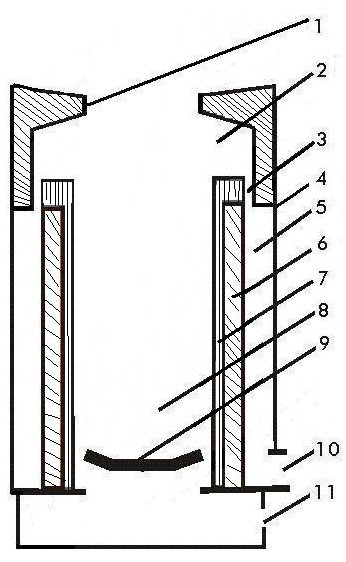Double-door double-control secondary air entering complete combustion technology
A secondary air intake and complete combustion technology, which is applied in the field of stoves and furnaces, can solve the problems of large black smoke, lower furnace temperature, heat loss, etc., and achieve the effects of smokeless temperature, strong heat accumulation, and complete combustion
- Summary
- Abstract
- Description
- Claims
- Application Information
AI Technical Summary
Problems solved by technology
Method used
Image
Examples
Embodiment Construction
[0010] The smaller-diameter first combustion chamber (8) and the larger-diameter second combustion chamber (2) form a T-shaped furnace, and the upper part of the second combustion chamber converges on the fire gathering ring (1), and the fire gathering ring (1 ) is the same as or slightly smaller than the furnace (7), so that the flames gather here and scour the bottom of the pot. The height of the second combustion chamber (2) depends on the situation, generally between 2cm and 10cm. When it is designed for coal-fired, it should be shorter, and when it is designed for firewood, it should be higher. When it is mixed, it is generally suitable to choose 4cm~5cm. In order to make the first combustion chamber (8) have a higher temperature, asbestos or expanded perlite is used outside the furnace (7) to make a heat insulation layer (6), between the insulation layer (6) and the furnace shell (4) It is a cavity (5) surrounding the entire furnace body. The upper end of the cavity (5) ...
PUM
| Property | Measurement | Unit |
|---|---|---|
| Height | aaaaa | aaaaa |
Abstract
Description
Claims
Application Information
 Login to View More
Login to View More - R&D
- Intellectual Property
- Life Sciences
- Materials
- Tech Scout
- Unparalleled Data Quality
- Higher Quality Content
- 60% Fewer Hallucinations
Browse by: Latest US Patents, China's latest patents, Technical Efficacy Thesaurus, Application Domain, Technology Topic, Popular Technical Reports.
© 2025 PatSnap. All rights reserved.Legal|Privacy policy|Modern Slavery Act Transparency Statement|Sitemap|About US| Contact US: help@patsnap.com


